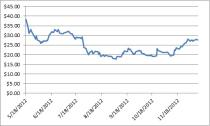Why Facebook In The 'Q’s' Doesn’t Matter
Facebook finally became part of the PowerShares QQQ Trust (QQQ) this week, and if you too heard the deafening silence, you’re not alone.
Part of the tepid reaction is that Facebook now makes up just 1 percent of the index. Sure, that’s more than zero, but it’s not an impressive enough number like Apple’s 16 percent weighting in QQQ to actually impact someone’s decision whether or not to buy the fund. Or at least, it shouldn’t be.
And to think, because of the Nasdaq-100 Index’s seasoning rules, we had to wait seven months for such an inconsequential weighting, when other ETFs added Facebook shares almost immediately after the firm’s initial public offering in May.
Of course, waiting may have served shareholders in the “Q’s” rather well.
After all, Facebook’s IPO was a huge flop. It opened at $38 and almost immediately plummeted, finally reaching a low of $17.73 on Sept. 4 for a peak-to-trough loss of more than 50 percent.


Personally, had I been a QQQ holder, I would have been OK with missing out on that drop. Even 1 percent of a 53 percent decline still hurts.
Of course, that sword swings both ways.
A rules-based index has no way of predicting which IPOs are going to do well and wouldn’t be able to respond even if it could. In other words, index-fund holders could just as easily miss a 50 percent rally in a newly issued stock.
But honestly, if you’re worried about the impact of single-stock inclusions on your bottom line, indexing may not be for you.
If you want someone to pick companies for you, hire an active manager. He may or may not be able to actually outperform the market and could just as easily bungle a hot IPO, but that’s life.
And again, even a 50 percent rally would be diluted according to the stock’s weight in a given index-based ETF.
There are four funds that all have bigger allocations to Facebook than QQQ and have held it for longer.
They are the Global X Social Media Index Fund (SOCLF), the First Trust US IPO Index Fund (FPX), the First Trust Dow Jones Internet Index Fund (FDN) and the PowerShares Morningstar StockInvestor Core Portfolio (PYH).
SOCL was the first ETF to add Facebook to its portfolio—on May 28—and holds the biggest position in the company, at 14.5 percent.
Two exchange-traded notes, the Etracs Next Generation Internet ETN (EIPO) and the Etracs Monthly 2X Leveraged Next Generation Internet ETN (EIPL) added Facebook exposure very quickly as well, and the social media company now has a weighting of about 10.5 percent.


But even SOCL hasn’t shown huge reactions to moves in Facebook.
That’s the beauty of indexing—you diversify away most single-security risk to instead isolate the market risk of the market you’re targeting.
What I’m getting at is that if you’re deciding whether to buy QQQ, looking at its new Facebook position is the wrong place to start.
Instead, I’d recommend looking at its portfolio in depth and figuring out whether the allocations as a whole make sense to you. For example, do you really want the 67 percent allocation to technology that the “Q’s” serve up?
That’s a blog for another day, and until then, it’s important to thoroughly think through why you might want to own Facebook and, from there, how.
At the time this article was written, the author held no positions in the securities mentioned. Contact Carolyn Hill at chill@indexuniverse.com.
Permalink | ' Copyright 2012 IndexUniverse LLC. All rights reserved
